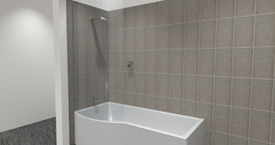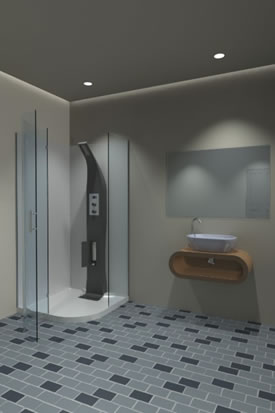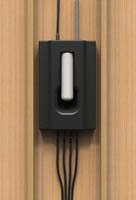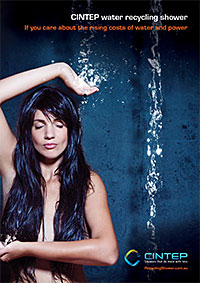- Does the shower meet CE /UL /Watermark and other standards?
The shower is being designed to comply with all relevant standards and certification will only be possible once the design has been finalised at the end of 2013. We will initially test to Australian standards but are able to ask the same accreditation and testing bodies to test to CE and UL.
- What is The Code for Sustainable Homes in the UK?
The Code for Sustainable Homes is an environmental assessment method for rating and certifying the performance of new homes in England, Wales and Northern Ireland. It is a national standard for use in the design and construction of new homes with a view to encouraging continuous improvement in sustainable home building.
To achieve level 1 requires using less than 120 litres of water per person per day. Level 6 reduces this to 80 litres per person per day. With an average shower lasting 7 – 8 minutes and traditional showers consuming 12 – 16 litres per minute it will become increasingly hard to achieve these standards. Even lower flow showerheads providing 6 – 9 litres per minute will use between 42 litres and 72 litres per person per day.
CINTEP’s shower will provide the same shower experience as a 9 litre per minute showerhead but use less than 20 litres of water per person per day.
Over a year this saving can exceed 20,000 litres per person. - How is the shower better for the environment?
A recycling shower is an important innovation because it provides an extremely significant reduction in water and energy consumption with no reduction in performance. Showers are the single largest use of water inside a house and the second largest use of energy after space heating and cooling. Showers are purchased on average about once every 10 years, which means the performance of the shower is locked in for that length of time.
CINTEP’s shower uses 70% less water and 70% less energy to achieve the same result as a conventional shower. If you care about the environment, or even just want to be able to take long showers with a clear conscience, the CINTEP shower is for you.
- What are the advantages over a water-saving shower head?
Most shower technology is locked in to 1 litre in equals 1 litre out so there is a conflict between buying an efficient low-flow product, or a performance based high flow product and the decision is “either / or”.
CINTEP’s shower system removes that conflict by providing 3.3 litres of water output at the showerhead for every litre of water input to the system.
This means CINTEP’s shower can provide both efficiency and performance in a single product.
- Does the shower have a water saving showerhead on it?
CINTEP’s shower is designed to provide 9 litres per minute of flow at the showerhead. You can use any showerhead of your choice that is rated to work at 9 litres per minute.
- What does it look like?
You get to choose how the system looks.
CINTEP’s shower can be installed as a concealed system in a wet room or over the bath and can therefore match any décor of your choice.

Alternatively you can select an optional modern tower appearance (tower is an optional extra)

CINTEP’s shower is completely flexible in appearance. The function of the technology is condensed into a single black box in the wall. The appearance is independent of that.
- How much space in the wall does the system need?
- How do you filter soap and shampoo?
Soap and shampoo is partly removed by the design of the first level filter and is partly removed by the third level filter.
There is a residual amount of soap and shampoo that survives the filtration process and is returned to the showerhead. This is diluted with 30% fresh water every 25 seconds and cannot be detected by odour, taste or touch.
If, for any reason, the shower user felt that the recycled water was not rinsing well enough the shower has a non-recycling mode that uses 100% fresh mains water and this can be used as a “rinse” feature if needed.
- How do I know it works?
We have built a number of fully functional prototypes and these have performed as well or better than expected. The design and prototypes won a Dyson Award, The British Standards Institution Environmental Design Awardand was selected by the Royal College of Artin London to be part of their selected works exhibition.
The company also won The Green Challenge, the world’s most valuable Clean Technology Competitionin 2011.
In 2012 we were selected by Popular Sciencemagazine as one of the 10 most important inventions of the year and by Business Insider as one of 30 Game Changing Innovations.
- What connections does the shower require?
- Does it require connection to a hot water system?
- Does it require a power connection?
- How does the water recycling system save energy?
The shower saves energy in two ways:
- The recycled water is already warm and therefore requires much less heating than the cold water used for all of your conventional shower.
- The recycling shower heats the water just before the showerhead, which means you immediately use all of the heated water, there is no wasted energy. Typically a storage hot water system will lose between 22% and 49% of all energy inputs through storage and distribution losses.
Simplistically of the 70% reduction in energy consumption, 40% of the 70% comes from using already warm water and 30% of the 70% comes from the elimination of system losses.
- How can it use less energy than my current hot water system?
You may think “but my hot water heater only uses 3 kilowatts and your shower uses 9.6 kilowatts how can yours use less energy?”
This is easy to explain if you consider that energy = power x time.
Your hot water system runs at 3 kilowatts (power) but it will run for 6 – 8 hours per day. Our recycling shower runs at 9.6 kilowatts but it only runs while you are in the shower – which if you are an average shower user, is 8 minutes per day.
- How does the water recycling shower work?
- What will the shower cost?
- What are the maintenance requirements?
This depends on how many people use the shower each day. In a normal household situation it is usually 2 people per shower – a husband and wife share an en-suite and the 2 children use a family bathroom).
If 2 people use the same shower each per day then you will require 2 filters per year. Each filter will cost less than AU$100.
If more people use the shower every day, for example in a Gym or a sports club, then you will need more filters, 3 people = 3 filters per year, 4 people = 4 filters per year etc.
In order to change the filter, you will need access to the system. We recommend that the system is installed in such a way that access is easy from the opposite side of the wall to the shower:

When access is not required this can easily be covered with a picture or a mirror.
- Can it be retrofitted easily?
- How much will I save?
On a like for like comparison with a conventional shower – same flow rate, same environment, same utility costs, and no change in behaviour of the user savings would be:
Energy savings
- 1,186 kilowatt hours per person per year
- 712 Kg CO2 per person per year (assuming 0.6kg per kWHr)
Water savings
- 21,681 Litres per person per year.
Cost savings
- £80 – £150 per person per year (net of filter cost) based on 2013 Uk utility costs.
Assumptions:
- CINTEP’s shower runs at 9.0 litres per minute at the showerhead.
- The conventional shower is also running at 9.0 litres per minute
- CINTEP’s shower has no cold water on start-up which saves 60 seconds of temperature setting
- Cold water is supplied at 10°Centigrade
- Shower temperature is 45°Centigrade for both showers
- Shower duration is 8.0 minutes (this is a statistical average from 3 surveys). The conventional shower therefore runs for 9 minutes including 60 seconds of temperature setting.
- There is an average of 1 shower per day per person over a year (365 showers per year)
- All other behaviour and variables are identical.
FAQ
- Does the shower meet CE /UL /Watermark and other standards?
- What is The Code for Sustainable Homes in the UK?
- How is the shower better for the environment?
- What are the advantages over a water-saving shower head?
- Does the shower have a water saving showerhead on it?
- What does it look like?
- How much space in the wall does the system need?
- How do you filter soap and shampoo?
- How do I know it works?
- What connections does the shower require?
- Does it require connection to a hot water system?
- Does it require a power connection?
- How does the water recycling system save energy?
- How can it use less energy than my current hot water system?
- How does the water recycling shower work?
- What will the shower cost?
- What are the maintenance requirements?
- Can it be retrofitted easily?
- How much will I save?

